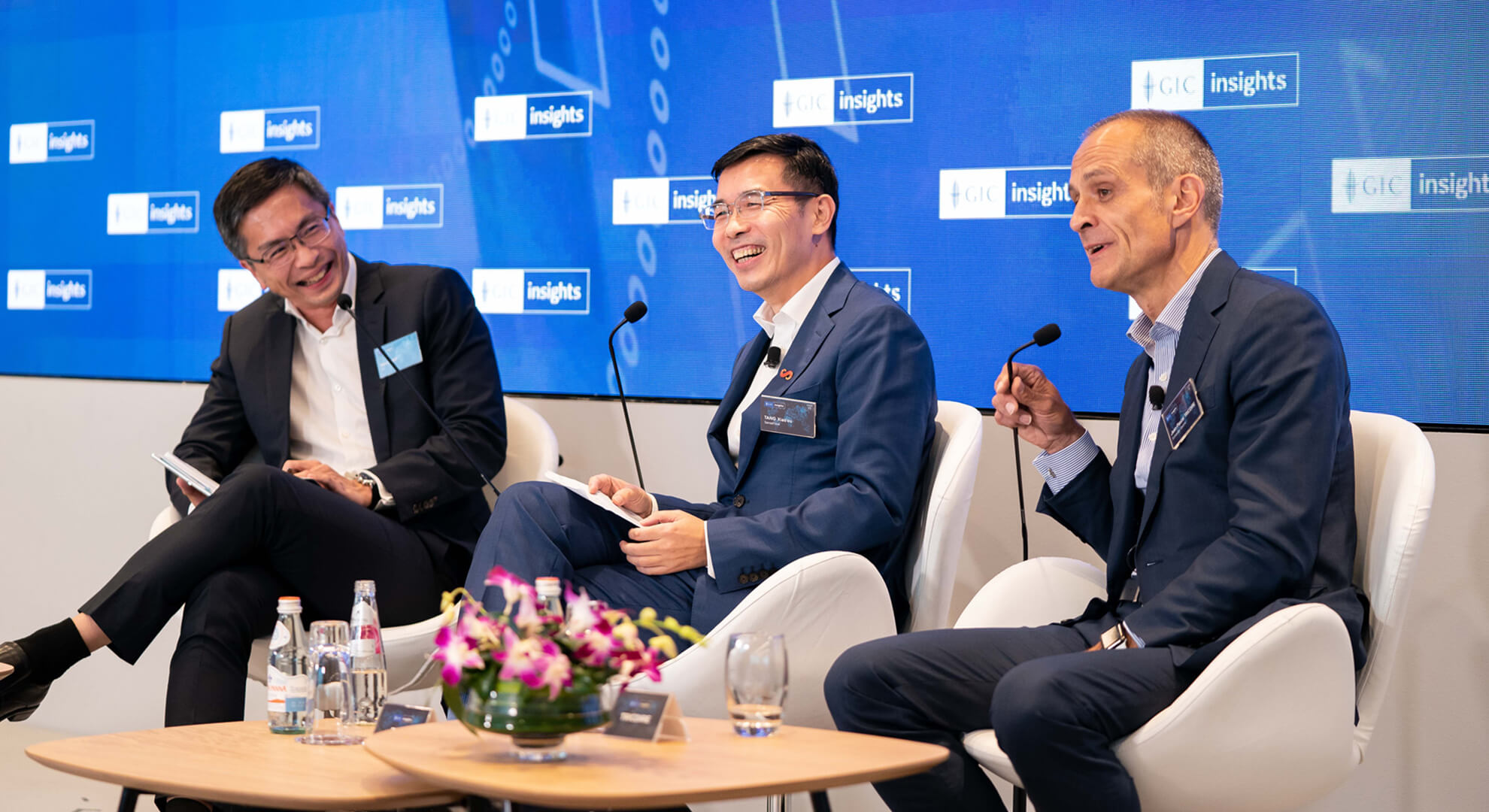This article presents takeaways from a session at GIC Insights 2019, where we heard from Professor Tang Xiao’ou, Founder of SenseTime, one of China’s leading AI companies, and Jean-Pascal Tricoire, Chairman and CEO of French energy multinational Schneider Electric, on their digitally enabled but highly divergent paths to leadership. GIC Insights is our annual flagship event that gathers a select group of prominent business leaders to deliberate over long-term issues pertinent to the international business and investment community.
From AI (Artificial Intelligence) to IA (Industrial Automation), technological innovation is transforming industries and changing the global competitive landscape. They are meeting the rapidly evolving and differentiated needs of consumers, while making traditional industries more efficient and sustainable.
Technology at the core
From driverless cars to robots in factories, new technology innovations driven by AI and IA are transforming industries and lifestyles in ways unimagined before.
At the vanguard of these technological innovations are SenseTime and Schneider Electric, two companies with very similar goals – new solutions and efficiency improvements – but highly distinct backgrounds.
SenseTime is a five-year-old Chinese unicorn contributing to the rising tide of AI while Schneider is a 183-year-old company with its legacy in energy distribution. Their paths to leadership are unique, but there is also potential for traditional incumbents and young disruptors to collaborate.
The future of AI
In just five years, SenseTime has emerged to become “the world’s most valuable start-up” with 3,500 staff and offices in Hong Kong, Shanghai, Tokyo, the Middle East, and Singapore.
In part, SenseTime’s rapid rise can be attributed to timing. It came into being at a time when China was already at the technological frontiers of electronics, machinery, automobiles, and high-speed railways, and driving the development of next-generation technologies, including robotics, AI, supercomputers, and virtual reality. As computer scientist-investor Lee Kai-Fu noted before, when the Chinese ecosystem focuses on one industry, ‘they can truly shake the world.’
Today, AI is embedded in everyday Chinese life, in applications from traffic management and safety, to even kitchen processes and hygiene standards compliance.
In building its AI business, SenseTime cites four factors as being key to its success:
- Talent: Securing talent in quality and quantity is key to AI and innovation, and a competitive advantage. To encourage a good flow of talent over the long term, SenseTime created an AI education platform across all levels. This ranges from publishing textbooks that stimulate interest in programming, mathematics, physics and science from primary to high school students, to providing central supercomputing resources for schools. At the college level, they have formed a Global AI Academic Alliance with the Massachusetts Institute of Technology (MIT).
- Data: AI relies heavily on the availability and quality of data. By working with many traditional companies right from the beginning, they were able to collect a lot of data, which was subsequently used for training and honing their algorithms.
- Computing power: SenseTime owns some of the world’s most powerful supercomputers, allowing their researchers to test out their ideas and bring new solutions to market more quickly than their peers.
- Industry partners: AI alone cannot do anything. It has to work in tandem with other traditional industries to have impact. SenseTime aims to work with the best or biggest players in each industry, who will have deep industry knowledge and data. For example, in autonomous driving, working with an established car manufacturer gives SenseTime access to invaluable data from millions of vehicles which they do not have on their own. In addition, by having exposure to different partners and industries, there are opportunities to further strengthen the eco-system by cross-selling relevant products and services and come up with new business models.
Industry 4.0: A digital transformation journey
Then there is Schneider, a 183-year-old incumbent, who now deploys technologies such as AI, Big Data and the Internet of Things (IoT), to help traditional industries like energy and manufacturing operate more efficiently and sustainably. This includes using cloud-based solutions which allow customers to track and respond to energy use in real time. Today, digital business accounts for 50% of Schneider’s revenue. Schneider’s transition to a global leader in energy management in IA took 15 years.
Chairman and CEO Jean-Pascal Tricoire shared three key strategies:
- Identifying climate change as a major issue to be resolved globally. Schneider identified climate change as a major issue that would compel corporations, especially those in the energy sector, to embrace sustainability as a strategic priority. The growing demand for carbon neutrality has since changed the profile of the company. Schneider has invested heavily in digitisation and IoT, with the goal to combat climate change and reduce CO2 emissions by up to 50%.
- Opting for open, inter-operable architecture instead of proprietary systems. This ultimately took the form of integrated solutions, which leverages on advancements around IoT, mobility, sensing, cloud, analytics and cybersecurity, to deliver innovation across all levels of the industrial process.
- Investing in China. Schneider used to be fairly transatlantic, operating primarily between Europe and the US. In the 1990s, despite low levels of urbanisation, industrialisation, and digitisation in China then, the company invested heavily in the country’s potential. Today, China is Schneider’s largest market, and where it has their highest headcount of 28,000 staff.
Schneider’s transformation journey has not been without challenges. They have had to deal with different energy networks and standards in each country, the need to enhance security and build trust in their systems, and re-skilling employees to meet the changing digital demands of the future. Having a forward-looking, collaborative, and strategic approach underpinned their success.
Bringing incumbents and start-ups together
One common thread that stood out was the companies’ clear vision and awareness of what they stood for and how they define their longer-term objectives.
First, SenseTime saw its role as being a business foremost, and not a research institute. Accordingly, it has been judicious in the way it has managed its funds, and has had its eyes set on long-term viability and profitability for its investors. For Schneider, it understood that its customers were turning to them not for their technology, but their ability to convert their use of technology into tangible benefits in energy and time savings, as well as increased productivity.
Second, both companies have an acute awareness of their value, as well as what others bring to the table. SenseTime recognises that while it has the technology, it lacks the scale and the years of experience that many industry veterans would have. Similarly, Schneider recognises that its value is in being able to ‘connect the world’ and collect massive amounts of data, which can be analysed to better inform decision-making for its customers. This process may be enhanced by AI technology at every level. Incumbents and start-ups can therefore have very complementary positionings.
Third, both are focused on the long term. For SenseTime, they understood the need to build a strong eco-system for long-term financial viability. For Schneider, they recognised the importance of balancing the need to change which could affect short-term profitability, and managing shareholders’ expectations while the change is going on.
Conclusion
Ultimately, companies who embrace AI and IA can extract major long-term business benefits from productivity and sustainability gains, gain a strong early-mover advantage in industry knowledge, talent and experience, and consequently position themselves well for longevity.







